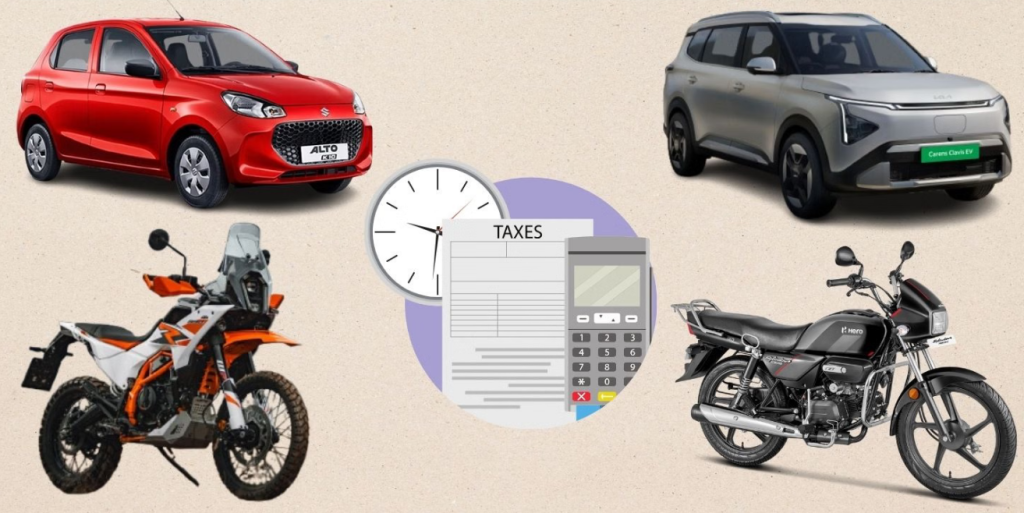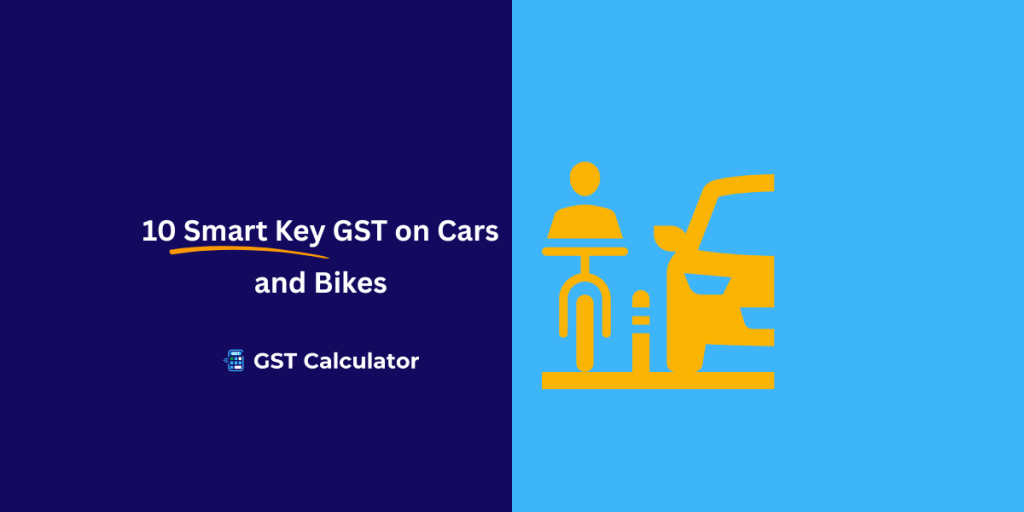Let’s discussed about GST on Cars and Bikes. Buying a new car or bike is one of life’s proudest moments. But when the dealer hands over the invoice, there’s a familiar line item that makes every buyer pause – GST on Cars or GST on Vehicles.
Since India’s Goods and Services Tax (GST) replaced excise, VAT, and other cascading taxes, it has completely changed how automobiles are priced and insured. Whether you’re purchasing a sedan, renewing bike insurance, or selling your old car, GST has an impact at every stage of vehicle ownership.
This comprehensive guide breaks down GST on Cars, GST on Bikes, and GST on Vehicle Insurance, explaining how rates are applied, how they affect cost, and how you can make smarter financial decisions in 2025.

Understanding GST on Cars and Bikes
The Basics
When you buy a car or two-wheeler, GST replaces the older taxes like excise duty, VAT, and road tax. Currently, GST on Cars and GST on Motor Vehicles fall under the highest slab of 28%, along with an additional compensation cess ranging from 1% to 22%, depending on engine capacity and vehicle type.
| Vehicle Type | GST Rate | Compensation Cess | Total Effective Tax |
|---|---|---|---|
| Small Cars (Petrol ≤ 1200cc, Diesel ≤ 1500cc, Length < 4m) | 28% | 1% | 29% |
| Mid-size Cars | 28% | 15% | 43% |
| SUVs | 28% | 22% | 50% |
| Electric Vehicles (EVs) | 5% | NIL | 5% |
| Two-wheelers | 28% | NIL | 28% |
Key takeaway: The automobile sector bears one of the highest GST slabs in India, and the overall tax can significantly increase on-road prices.
How GST Impacts Car Prices
Before GST, buyers paid excise, VAT, and infrastructure cess – together totaling between 30% to 48%. GST simplified this into a single 28% rate plus cess.
Example:
- Base price of a mid-size car: ₹10,00,000
- GST @28% = ₹2,80,000
- Compensation Cess @15% = ₹1,50,000
- On-road price (before registration/insurance) = ₹14,30,000
So, even though GST made billing easier, the combined tax still pushes the total cost up by 40% to 50%.
GST on Bikes and Two-Wheelers
Two-wheelers, from scooters to superbikes, attract 28% GST, but they don’t have an extra cess like cars.
Example Calculation
- Base price of bike: ₹1,00,000
- GST @28% = ₹28,000
- Total = ₹1,28,000
For luxury bikes above 350cc, compensation cess (3%) may apply. Manufacturers and dealers pass the cost directly to consumers, making affordability a concern for budget-conscious riders.
GST on Vehicle Insurance Premiums
Most car and bike owners overlook that insurance premiums are also taxable under GST. When you renew your policy, GST on Car Insurance or GST on Bike Insurance applies at 18% on the premium amount.
Example Calculation:
- Comprehensive car insurance premium: ₹10,000
- GST @18% = ₹1,800
- Total payable = ₹11,800
Types of Insurance Affected:
- Third-party liability policies.
- Comprehensive policies (own damage + third-party).
- Add-ons like zero depreciation, roadside assistance, etc.
So, the higher your insurance coverage, the higher the GST on Vehicle Insurance you’ll pay each year.
Calculate GST at: https://mygstcalculator.com/
GST on Sale or Purchase of Used Cars
Buying or selling used cars also attracts GST, but with different rules. In 2018, the GST Council introduced margin-based taxation for second-hand vehicles.
| Vehicle Type | GST Rate on Margin | Notes |
|---|---|---|
| Small Cars (≤1200cc / ≤1500cc Diesel) | 12% | Only on dealer’s margin |
| Larger Cars / SUVs | 18% | Margin scheme applies |
| Electric Used Cars | Exempt | To promote EV adoption |
Example:
Dealer buys used car for ₹6,00,000, sells for ₹6,50,000.
- Margin = ₹50,000
- GST @18% = ₹9,000
That means tax is levied only on profit, not total sale value. Individuals selling personal vehicles to other individuals don’t have to charge GST.
GST on Car Insurance Renewals and Add-ons
Every time you renew your vehicle insurance, GST continues to apply. Add-on covers such as engine protection, consumables, or tyre damage each attract 18% GST.
Pro Tip: Combine your add-ons when renewing; you’ll save on processing charges even though the GST on Car Insurance remains constant.
GST on Spare Parts and Vehicle Services
Whenever you visit an authorized service center, your bill includes GST on Spare Parts and GST on Services.
| Type of Service | GST Rate | Remarks |
|---|---|---|
| Spare parts & accessories | 28% | Same as goods rate |
| Labor / maintenance service | 18% | Standard service rate |
| Roadside assistance | 18% | Taxed as service |
This dual structure means a typical service bill mixes 18% and 28% taxes depending on item category.
GST on Extended Warranty and AMC
Extended warranties or annual maintenance contracts (AMC) are also taxable at 18% GST.
Example:
- Extended warranty plan: ₹5,000
- GST @18% = ₹900
- Total = ₹5,900
Consumers often overlook this when comparing plans online – but it contributes to total vehicle ownership cost.
How GST Affects Vehicle Ownership Cost
When you add up GST across purchase, insurance, and maintenance, it becomes clear how much it influences the lifetime cost of owning a vehicle.
Illustration – Five-Year Car Ownership (₹10 lakh sedan)
| Component | Tax Applied | Amount (approx.) |
|---|---|---|
| Purchase | 28% + 15% cess | ₹4.3 lakh |
| Insurance (5 years @ ₹12k premium) | 18% | ₹10,800 |
| Maintenance & parts | 18–28% | ₹40,000 |
| Total GST impact | – | ₹4.8 lakh+ |
That means nearly half of your car’s price goes toward taxes over its lifetime!
GST on Electric Vehicles (EVs)
Electric cars and two-wheelers enjoy a concessional GST rate of 5% (no cess), encouraging green mobility.
Example:
- Base price ₹10,00,000
- GST @5% = ₹50,000
- Final = ₹10,50,000
Compared to petrol cars taxed at nearly 50%, this is a huge incentive for EV adoption.
GST on Car Leasing and Rentals
Car leasing and rental companies charge GST at 18% on lease rent. If they purchase vehicles for rental fleets, ITC rules vary:
- ITC not allowed for personal-use vehicles.
- ITC allowed for commercial rental fleets.
Example:
Monthly lease rent ₹25,000 → GST @18% ₹4,500 → Total ₹29,500.
Business Owners and Input Tax Credit (ITC)
Businesses can claim ITC on GST on Vehicles used exclusively for business purposes – such as demo cars, fleet taxis, or delivery vans.
Conditions:
- Vehicle must be capitalized in books.
- Supplier invoice must mention GSTIN.
- The vehicle must be used for taxable supplies.
Not eligible: Director’s personal cars, employee use, or mixed-purpose vehicles.
GST on Car Loans and Financing
Interest on car loans isn’t taxable, but processing fees and documentation charges attract 18% GST.
Example: ₹2,000 processing fee → GST ₹360 → Total ₹2,360.
Banks and NBFCs must issue tax invoices for these charges.
Common Misconceptions About GST on Vehicles
- “Personal car purchase ITC can be claimed.” → False
- “Used cars are exempt from GST.” → Only if sold by individuals, not dealers.
- “EVs have no GST at all.” → 5% GST still applies.
- “Insurance renewal doesn’t have GST.” → 18% always applies.
Future Outlook – Will GST on Cars Decrease?
Auto industry associations have long requested that GST on Cars and Bikes be reduced to 18% (from 28%) to boost demand. However, the GST Council has maintained higher slabs due to revenue needs.
There’s talk of rationalizing cess slabs to align with global EV adoption and carbon reduction goals, but no firm date yet.
FAQs – GST on Cars, Bikes & Vehicle Insurance
What is the GST rate on new cars in India?
28% GST + 1–22% compensation cess, depending on engine size and car category.
Is GST applicable on insurance renewals?
Yes, all vehicle insurance premiums attract 18% GST, even for renewals.
Do I pay GST when selling my old car?
Individuals don’t, but registered dealers do – on the margin under GST rules.
Is GST on Bikes the same as cars?
Bikes attract 28% GST without cess; cars vary between 29–50%.
What is the GST rate on electric vehicles?
EVs are taxed at just 5%, no cess applicable.
Conclusion
From showrooms to service centers, GST on Cars, GST on Bikes, and GST on Vehicle Insurance touch every corner of vehicle ownership. While GST simplified the taxation process, it also adds significant cost – nearly half your car’s lifetime expense is tax-driven.
As EVs grow and policy evolves, we may soon see rationalized rates and better incentives for green vehicles. Until then, understanding these GST layers helps consumers and businesses plan smarter and stay compliant.

